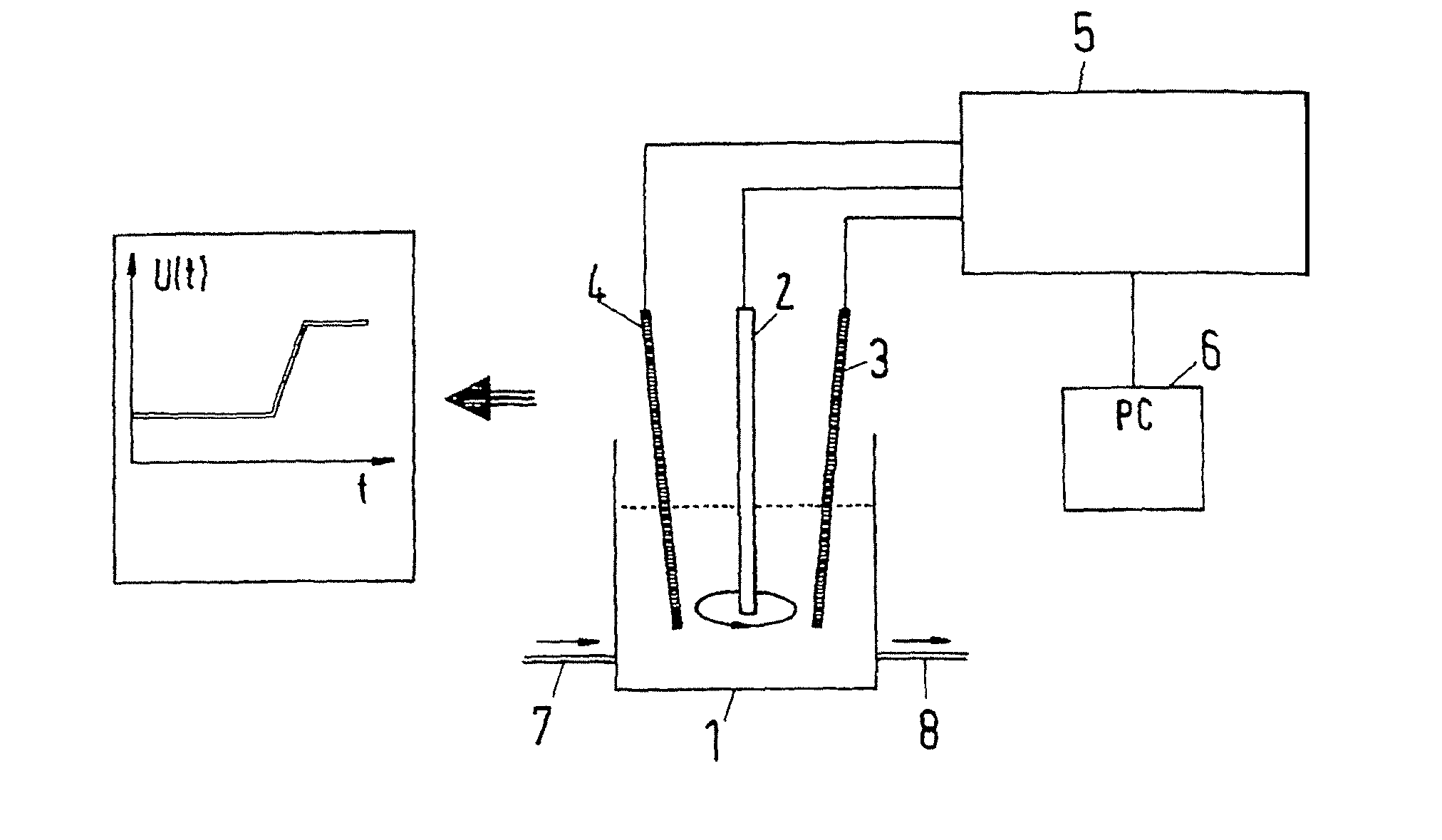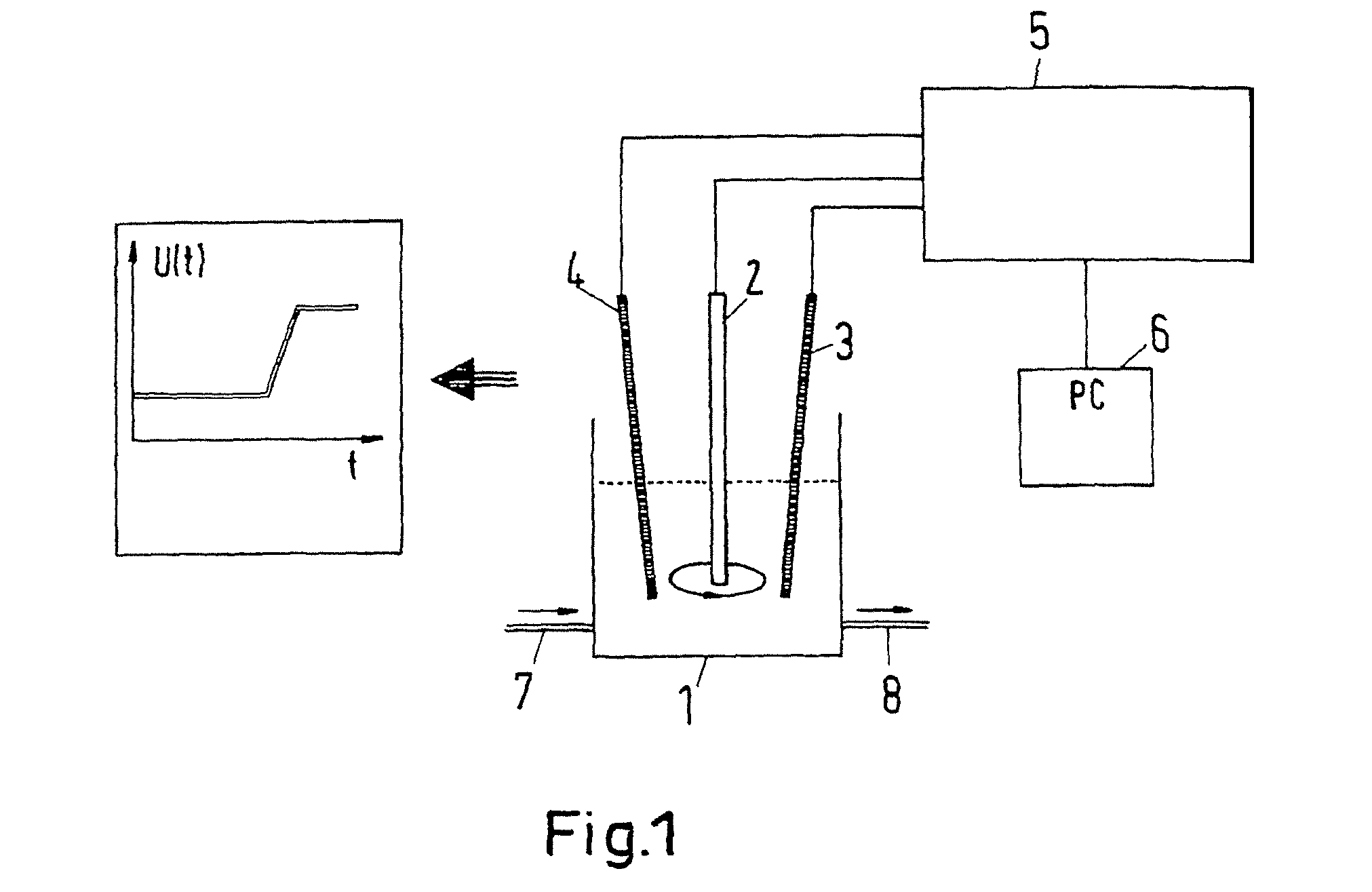Method of inspecting a metal coating and a method for analytical control of a deposition electrolyte serving to deposit said metal coating
a metal coating and analytical control technology, applied in the direction of liquid/fluent solid measurement, instruments, cells, etc., can solve the problems of not being able to see whether the manufactured parts meet the requirements, the test of parts is very long, etc., and achieve the effect of high quality
- Summary
- Abstract
- Description
- Claims
- Application Information
AI Technical Summary
Benefits of technology
Problems solved by technology
Method used
Image
Examples
example 1
[0054]The measurement arrangement schematically shown in FIG. 1 comprises a measurement cell 1 in which there are located three electrodes: a working electrode 2, a counter electrode 3 and a reference electrode 4. The working electrode 1 is a rotating platinum electrode. The counter electrode 3 is a platinum wire and the reference electrode 4 is a silver wire that is coated with a silver chloride coating. The rotating platinum electrode 2 consists of a cylinder made from Teflon® (DuPont de Nemours), in the end side of which there is embedded a platinum disc of 0.071 cm2 in size. The cylinder rotates about its axis at 500 rpm. As a result, electrolyte contained in the measurement cell is circulated in a continuous flow to the surface of the platinum disc so that constant hydrodynamic conditions prevail at the platinum surface. The electrodes 2, 3, 4 are connected to a galvanostatic current source (galvanostat) 5. Thanks to the galvanostat 5, the current flowing between the platinum e...
example 2
[0068]In another test design, the bright nickel coating and the semi-gloss nickel coating were deposited under different conditions and the thus obtained values for the dissolution potential after calculating the difference between the corresponding combinations of bright nickel coatings and semi-gloss nickel coatings were compared with values determined accordingly with the STEP test. The conditions for depositing the bright nickel coatings and the semi-gloss nickel coatings corresponded to those that had already been chosen in Example 1 if no other conditions are indicated herein after. The current density during deposition of the nickel coatings as well as the concentration of the additive determining the corrosion behaviour in the semi-gloss nickel were respectively varied. Tab. 1 compares the results of these tests against each other.
[0069]The difference values obtained with the method of the invention roughly coincide with the values obtained with the STEP test. Principally, i...
example 3
[0073]In another test, the influence of the electrolyte load, of the concentration of the semi-gloss nickel additive and of the current density during deposition of a semi-gloss nickel coating on the dissolution potential was examined. The electrolyte load is the charge imposed in the deposition electrolyte in the tank (15 l volume) to deposit semi-gloss nickel per volume unit, expressed in [A·h / l]. For this purpose, copper sheets were coated with semi-gloss nickel at different current densities (see Table 1). The dissolution potential was measured like in the Examples 1 and 2 with a current density of 26 A / dm2 on a platinum electrode rotating at 500 rpm. The potential was averaged as shown in Example 1.
[0074]For this purpose, a semi-gloss nickel electrolyte having a composition like in Example 1 was prepared in a bath tank holding 15 l. The additive was the same as described in Example 2. The additive concentration was at first 0 ml / l. Each rise in the additive concentration was ad...
PUM
| Property | Measurement | Unit |
|---|---|---|
| thickness | aaaaa | aaaaa |
| thickness | aaaaa | aaaaa |
| time | aaaaa | aaaaa |
Abstract
Description
Claims
Application Information
 Login to View More
Login to View More - R&D
- Intellectual Property
- Life Sciences
- Materials
- Tech Scout
- Unparalleled Data Quality
- Higher Quality Content
- 60% Fewer Hallucinations
Browse by: Latest US Patents, China's latest patents, Technical Efficacy Thesaurus, Application Domain, Technology Topic, Popular Technical Reports.
© 2025 PatSnap. All rights reserved.Legal|Privacy policy|Modern Slavery Act Transparency Statement|Sitemap|About US| Contact US: help@patsnap.com



